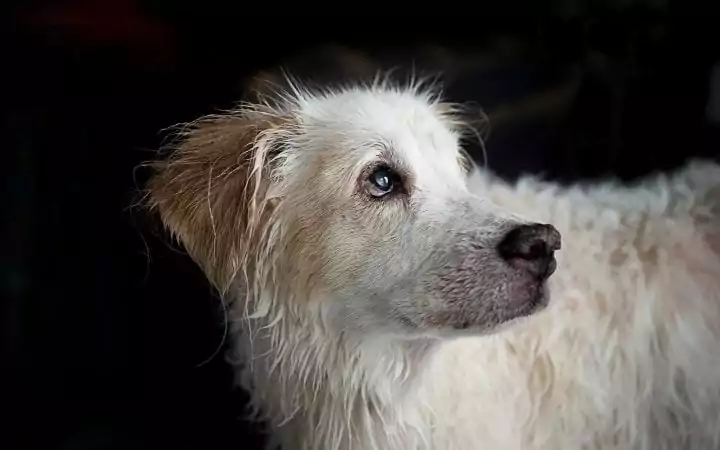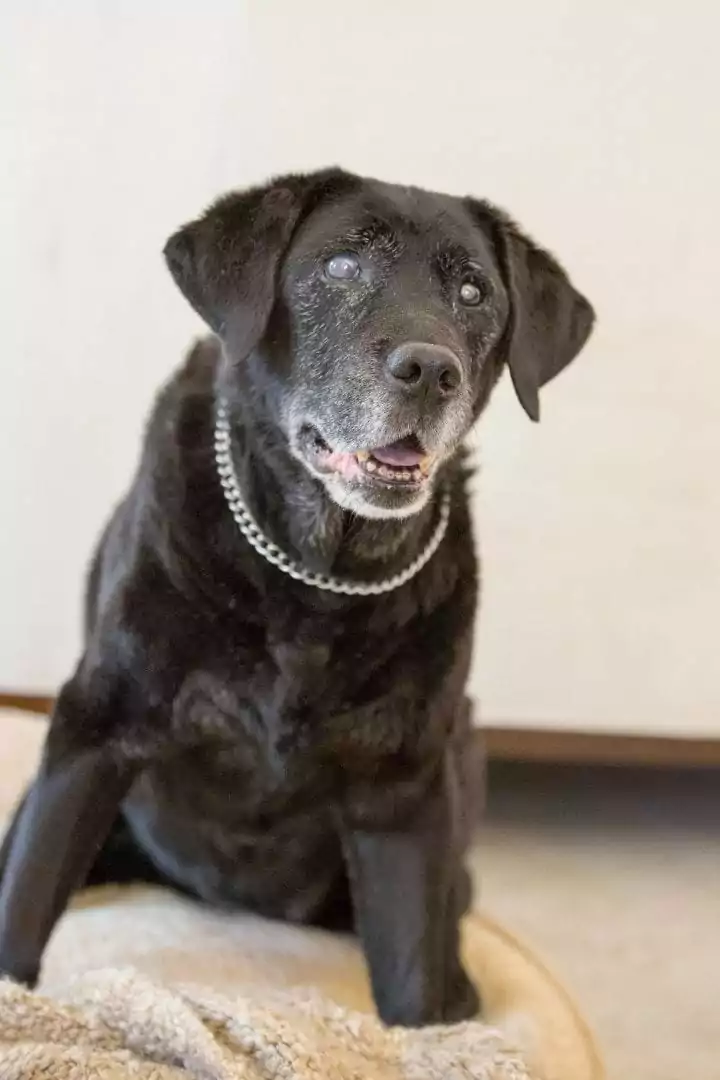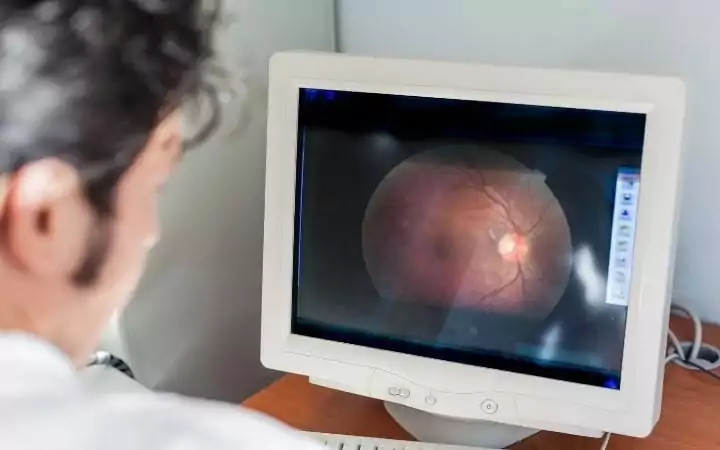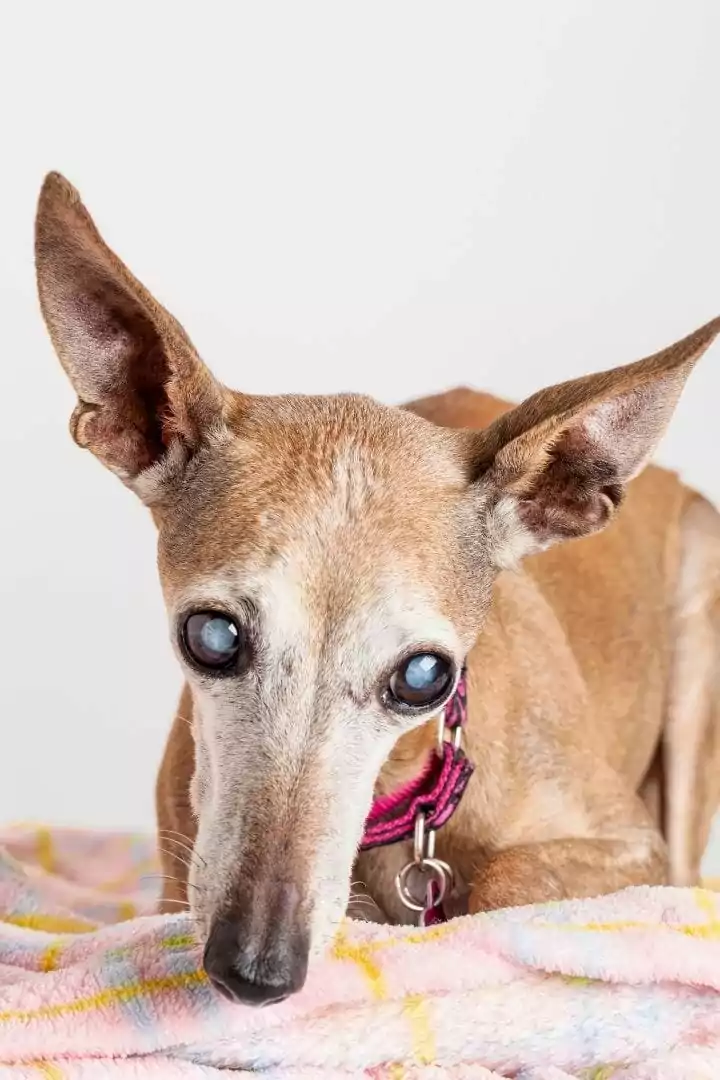What are Cataracts in Dogs?
Cataracts are pretty obvious when you’ve seen them once. The telltale cloudy and bluish appearance is the giveaway. To understand cataracts, we need to understand the basic anatomy and physiology of the eye.
Inside the eye, we have the retina, which is where vision takes place. The lens is what takes the light passing through and focuses it. When this lens becomes opaque/cloudy (which can be from many different reasons), it is called a cataract.
Classification of Cataracts
Cataracts are classified by:
- Cause: primary (genetic basis), and secondary (occurring from trauma or disease)
- Age of onset: congenital (developing at or shortly after birth), juvenile (developing during your dog’s younger years), and senile (development during a dog’s senior years)
- Location within lens
- Degree of completeness: Incipient- no visual defects, Immature- slight visual imperfections, Mature- significant visual defects with partial or full blindness, and Hypermature- shrunken lens, +/- uveitis.
- By having a classification you and your veterinarian will be able to pick a thought out plan to treat your dog’s cataracts.
What Causes Cataracts in dogs
Cataracts may develop due to many things. Underlying diseases such as Diabetes Mellitus can cause cataracts as well as injuries or traumas. Uncontrolled Diabetes Mellitus may lead to cataracts because the overload of glucose can cause the eye lens to swell.
This glucose in the eye will eventually be converted into a substance called sorbitol. Sorbitol can change the proteins in the lens’ cells causing them to become cloudy. Cataracts can also occur from old age but are most commonly caused from genetic/inherited diseases (diseases your dog is born with).
Are some breeds more prone than others?
As with most canine diseases there are some breeds that attract cataracts and will get them without any secondary causes. These breeds include:
- American Cocker Spaniels
- Havanese
- Bichon Frise
- Poodles (both miniature and standard)
- Schnauzers (miniature)
- Boston Terriers
- Labrador Retrievers
- Welsch Springer Spaniel
- Dogs that are prone to diabetes such as the Miniature Pinscher and the West Highland White Terrier.
What is the difference between Cataracts and Lenticular Sclerosis?
Many owners can confuse Lenticular Sclerosis for Cataracts. So let’s discuss the difference between the two. On gross examination, the two conditions may look very similar. Cataracts as we know is the cloudiness of the lens, and Lenticular Sclerosis is the hardening of the lens.
Cataracts as we discussed are from underlying or inherited diseases. Lenticular Sclerosis is more of a right of passage as dog ages. As a dog gets older their lens begins to become compressed.
This compression may lead to the hardening aspect we spoke about before. By becoming hard the lens is unable to bend letting less light through. Lenticular Sclerosis usually affects both eyes but does not affect vision. Cataracts do affect vision and usually develop in both eyes at different times. Depending on the severity, dogs usually become blind with cataracts.
How To Tell If Your Dog Has Cataracts
Cataracts are typically easily spotted. A blueish gray tinge to your dog’s eye is a good indicator of them. However, going to see a veterinarian is key in differentiating between cataracts and other optic conditions like Nuclear Sclerosis.
Often an ophthalmologist is needed to further find the cause of cataracts. The eye is visual through the retina which uses photoreceptors known as rods and cones. They are responsible for seeing color, as well as the eye’s response to bright and dim light.
A test called an electroretinogram (ERG) is used to determine the retina’s functionality. It works by using a light source to expose the retina. The electrodes inside the retina create a waveform that is then analyzed. This test is performed alongside bloodwork, and urinalysis to rule out other diseases.
Treatment Options For Cataracts In Dogs
The only treatment for cataracts is surgical removal through a process called phacoemulsification (surgery where the dog’s lens is emulsified and aspirated from the eye). You may opt for the surgery in order to give your dog vision again, so an ERG test must be performed prior to the surgery.
This test is mandatory to determine the status of the retina. If the retina function is severe or fully diminished your dog is not a candidate for the surgery. Besides repairing vision cataracts can be removed to eliminate discomfort. Surgery consists of a small incision, followed by the insert of a probe that creates ultrasonic waves to break up and remove the cataract.
Following this, an artificial lens is put in place to restore your dog’s vision. Owner compliance is of the utmost importance to ensure the success of the surgery. An Elizabethan collar must be worn by your dog for about a month, along with eye drops and oral medications are given around the clock. Bilateral cataract surgery can be performed if the doctor deems this necessary.
Sometimes surgery is not needed and your veterinarian may choose to watch the cataract and give drops for any secondary inflammation. In other cases, it is not the ideal choice because it can be very expensive. If this is the situation then keep in mind that dogs can live a very happy life with cataracts.
There are other resources that your veterinarian can provide in order to help your dog cope with partial or full blindness. If surgical intervention is not an option frequent eye exams must be performed.
Untreated cataracts can cause a painful condition called uveitis (inflammation of the eye) from the cataract dissolving. Also, pieces of a cataract can break off and float around in the eye before settling in an area, and may cause a fluid blockage. This fluid blockage can lead to glaucoma (a condition that causes blindness from damage to the optic nerve).
Prevention of Cataracts
Unfortunately, there is no true prevention of primary cataracts in dogs. However, there are many things we can do as dog owners to help prevent secondary cataracts. Taking your dog to yearly routine visits to have their eyes checked is super important.
This allows for any early intervention for developing eye disease. Also if you notice anything off with your dog’s eyes or vision take them to see a veterinarian right away. Things to look out for would be conjunctivitis (inflammation of the conjunctiva/red eyes), discharge from the eye, squinting, bluish tinged eyes, and your dog bumping into furniture to name a few.
Diseases such as diabetes mellitus can be avoided by keeping your pet on a proper diet and avoiding overfeeding. Regular exercise and vet care is also another way to prevent diabetes from happening.
Summary
Cataracts can range from harmless to harmful. Without your veterinarian’s expertise it would be impossible to determine which stage your dog is in. In the end, it’s always best to consult with your veterinarian on the next steps.
By doing so early on you are able to make a plan that gives your dog’s vision a fighting chance. Also, having all the information will help you make a well rounded, educated plan. Vision is a vital sense for your dog, and being pain free is number one.
Treat your dog’s eyes as an emergency and err on the side of caution. This way you will always be ahead of the progression of the disease.





